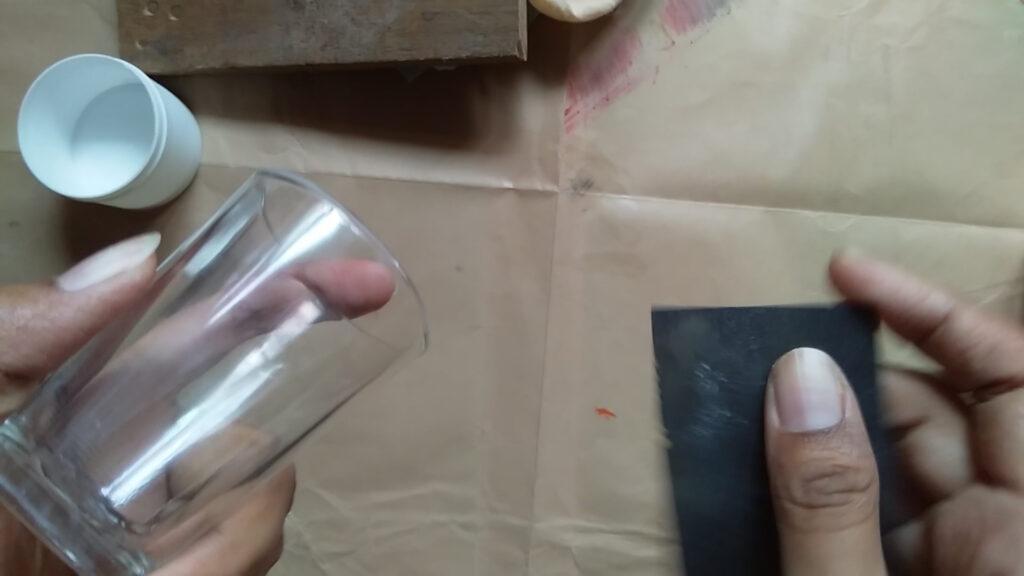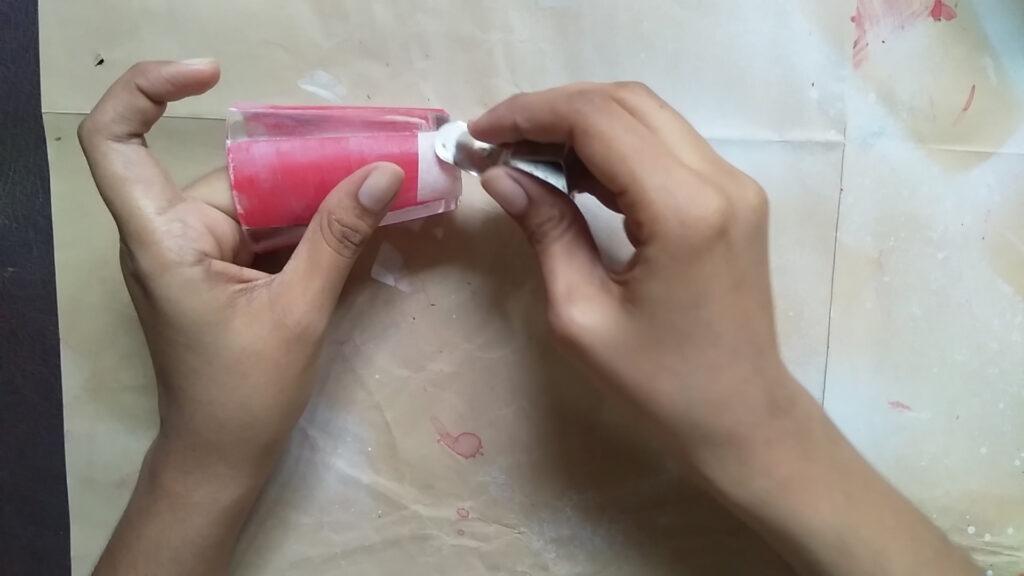Glass is an attractive surface to paint on due to its transparent property. As acrylic paint is very versatile and sticks to almost anything, it is a great convenient paint to use on glass. But you might wonder how to get acrylic paint to stick to glass.
Acrylic paint can stick to the bare glass surface as finished work is used only for decorative purposes without any scratching or contact of moisture. For more abrasive uses, glass needs to be prepared by sanding, priming with an industrial primer, and gesso. Finally, seal with acrylic clear coating.
I have recorded the whole process of sticking acrylic paint on 4 different surfaces (wood, plastic, metal, and glass). I experiment with 3 different methods of sticking acrylic paint and will tell you what is the best method for what surface. You can watch the below video and follow along with me.
The method of acrylic paint application and surface preparation changes with the purpose of the finished product. But Is acrylic paint permanent on glass?
Acrylic paint is permanent on the glass when the surface is prepared well and sealed with an acrylic clear coating. However, if the finished work is only used for display purposes, no preparation or sealing of the paint is required. This is especially in the case of anime acrylic glass painting.
Materials you will need
Below I have included a list of materials you will need to stick acrylic paint on glass with links to view the products on Amazon.
- Acrylic paint –Liquitex BASICS 6 Tube Acrylic Paint Set
- Glass primer (water-based)- KILZ Adhesion High-Bonding Interior Latex Primer/Sealer
- Glass etching cream- Armour Etch Etching Cream
- Acrylic gesso- Liquitex BASICS Gesso
- Acrylic matte medium- Liquitex BASICS Matte Fluid Medium
- Glass medium- FolkArt Medium Glass and Tile
- Acrylic gel medium- Liquitex BASICS Gloss Gel Medium
- Clear acrylic coating- Krylon Artist and Clear Coatings Aerosol, Clear Gloss
- Piece of cloth
Step 1: Clean and degrease the glass surface
Cleaning the glass surface is very important as glass is very smooth and rigid. First, clean the glass with water and soap. Dry with a piece of cloth. Then apply rubbing alcohol or isopropyl alcohol onto the glass and rub with a paper towel well. You can get rubbing alcohol from a pharmacy.

It will remove any grease on the surface. Make sure to not touch the surface of the degreased glass. Because the grease on your hand will make it harder for acrylics to stick onto the glass. You can wear rubber gloves to prevent grease from getting in the way.
Note: If you are doing work that uses the transparent nature of glass, then do not proceed to the second step, which is sanding. An example is the case of anime glass painting. You can directly go to the acrylic paint applying step after cleaning and degreasing the glass.
Step 2: Sand the surface with a 400 grit sandpaper
Sanding the glass surface is important to provide a tooth to it. So that the acrylic paint can better stick to the surface. Sand the glass surface with fine-grit sandpaper with 400 grit. After sanding the tooth are not that visible. You will bearly see the scratch marks on glass-like in the below image and it is fine.

Make sure that you do not leave any grease from your fingers on the glass. If you did, take a piece of cloth with rubbing alcohol and rub and remove it.
Since it is hard to make tooth for paint to adhere to glass just by sanding, the next step of etching or sandblasting the glass is important. However, it is optional. You can skip the etching step and proceed to the prime step after sanding the surface.
However, if you want really good adhesion for heavy-duty uses, then acid etching the glass or sandblasting is important.
Step 3: Acid etch or sandblast the glass surface
Acid etching or sandblasting the glass surface is important to provide grit or tooth to the surface. These processors also make the glass translucent and give it a milky white appearance. You can see a design done by acid etching glass in the below image.

Sandblasting uses a stream of high-velocity air to propel very fine bits of materials off a surface. Sandblasted surfaces are generally rougher than acid-etched glass. You cannot see through a sandblasted glass. But the light still travels through that glass.
Acid etching of glass uses a very strong acid to cut into the glass surface. Compared to sand-blasted glass, acid-etched glasses have a smoother, uniform surface, that admits light. If you are doing this project at home the best way to do it is by acid etching.
You can get an acid etching cream on Amazon such as Armour Etch. You need to be careful with the cream as it can contain very strong acids. Acid etching glass is by far the best way to stick acrylic paint to the glass. Also, you can use this etching cream on a bunch of other different projects too.
Following is a youtube video that explains how to etch glass with etching cream.
Step 3: Apply a glass primer or acrylic medium and gesso
Now is the time to prime the glass surface. For this, you need to use an industrial glass primer. After priming the surface the glass will no longer be transparent unless you are using a translucent primer. Kilz Adhesion is an excellent primer for this purpose.
If the glass got contacted with oil or grease at this point, make sure to clean the glass with rubbing alcohol or white vinegar using a piece of cloth as before. After applying the primer let it fully dry. Now you can check if the primer adhered to the surface well by following the adhesion test in step 5.
Priming is one of the key steps that make acrylic paint stick onto a surface. Then lightly sand the primed surface and apply a coat of gesso. Let it dry overnight. Now the surface is ready to be painted with acrylic paint.


If you do not want to bother with buying an industrial glass primer, there is another good solution. You can use acrylic mediums instead of industrial primer. Acrylic mediums act as glue and have better surface adhesion than gesso or acrylic paint. You can use acrylic matte medium or gel medium. The gel medium has the best adhesion.
You can apply acrylic matte medium or gel medium first onto the degreased surface. Wait for around two hours for the medium to dry and then apply gesso. Let the acrylic medium and gesso dry for 3 days.
You can also use FolkArt glass medium. Just like with acrylic medium, paint the glass first with FolkArt glass medium. Then you can proceed to the next step of painting with acrylics. Other than that you can mix FolkArt glass medium with acrylic paint and apply.
Priming with acrylic medium and gesso is a good choice if you have etched the glass surface previously. Then the glass will have better finishing than just applying acrylic medium on a sanded surface.
Now you can test the adhesion of gesso or acrylic medium to glass by following the adhesion test in step 5.
Step 4: Apply acrylic paint on the primed surface
Now that the primer or gesso is dry and the surface is prepared, you can apply acrylic paint. first lightly sand the primed surface and apply the paint. You can use craft acrylics or student-grade acrylics for this surface. As most glass painting projects are craft projects it is best not to waste any artist-grade acrylics for these projects.
Liquitex BASICS (link to view on Amazon)is a student-grade acrylic paint and is a good choice for these projects. After painting let the acrylic paint cure for at least 3 days. In the curing process, all the water in the acrylic paint film will escape and the paint film will harden on the surface and have better adhesion to the surface.


As mentioned before, you can mix acrylic paint with FolkArt glass medium. It will help the paint to better stick to glass. It will especially help if you did not etch the glass before. All other glass preparation methods are necessary even if you use a craft glass medium like FolkArt.
If you use an industrial metal primer, after applying acrylic paint, it will have the best coverage and the smoothest surface. The acrylic medium and gessoed surface stick with acrylic paint and glass well but the finishing was not elegant as the industrial primer and there was less coverage.
This can be affected by the transparency of the gesso used. However, the most elegant, fine-quality look was obtained with industrial glass primer.
Also, make sure that you do not ever paint on a rigid smooth surface like glass only primed with gesso. It will completely ruin the look of the acrylic-painted piece. In this case, it is best to use a water-based glass medium.
Step 5: Check the surface adhesion with an adhesion test
Now that you have let the acrylic paint cure for 3 more days, you can perform the adhesion test. The adhesion test checks how well the paint has adhered to a surface. Follow the below steps to do the adhesion test.
- When the paint is fully dry, score the paint surface in a crosshatch pattern with a sharp knife.
- Apply masking tape on the scored surface and burnish it well.
- Remove the masking tape slowly.
- If any paint comes off with the masking tape, a good surface adhesion is not achieved. This happens when you haven’t allowed the paint to fully cure, surface preparation is not done correctly or when the paint and primers are not compatible with the plastic surface.
If you haven’t let the painted surface cure for more than 3 days, redo the adhesion test after fully curing the paint. Try preparing the surface again as mentioned in steps 1 and 2 and redo the adhesion test. If these did not work using a different primer or paint will help.
Following are the results I got for the adhesion test from the industrial primer surface and acrylic medium and gessoed surface.


Acrylic paint adhered well to the gesso and acrylic medium surface. However, the industrial primer was not compatible with the paint. The paint peeled off when the surface is scratched. This might be because of the way I applied acrylic paint on the industrial primed surface.
Make sure you sand the industrial primer lightly before applying gesso. It will better adhere to the paint film. Even though the paint scratched I proceeded to the next step of applying the acrylic clear coating and the paint did not scratch anymore.
If you find that acrylic paint does not stick to glass even though you followed the steps exactly as it is, the option will be to use a paint that is specifically made for glass surfaces. Following are links to some of the best brands of glass paints available on Amazon.
Some tutorials on the internet about how to stick acrylic paint on glass, tell you to bake acrylic paint to cure it on glass. Baking acrylic paint is not a good idea as it will not help paint film formation but may break the paint film. Also, it will not be healthy as heating acrylic paint which is plastic can be unhealthy.
If you are interested to know more about baking acrylic paint, you can read the following article; Can you bake acrylic paint? the best way to go for it.
Step 6: Apply a clear acrylic coating for extra protection
This is one of the most important steps of sticking acrylic paint onto glass. Even if the acrylic paint did not seem to stick to the glass well, applying a clear coat and curing the acrylic coat for 3 days will fix the acrylic paint on the glass.
Finishing your work with a clear acrylic coating will protect the painted piece from environmental factors such as moisture, dust, and UV rays.
You can use the Krylon Artist and Clear Coatings Aerosol (link to view on Amazon) for this purpose. Make sure to wait until the paint is fully cured. As mentioned before 3 days is enough for thin paint layers to cure. But for thick paint layers or in high humidity, it will take around 1 to 2 weeks to fully cure the paint.
I have written a whole article about acrylic paint being sticky when the paint is not fully cured (link to the article). You will find many factors that can affect the drying process of acrylics and the best ways to tackle them in the article.
After acrylic paint is fully cured apply the clear coating. let the clear coating dry for at least 3 days. It will take more than 3 days to cure the acrylic coating in a humid environment.

I sprayed some water on the industrial primer applied surface and acrylic medium and gessoed glass surface to test how the finished work can hold water. Clearcoat holds the water very well and acted as a barrier between the paint and water in every method of sticking acrylic paint. If you are going to keep your finished work outside, or if you want to give extra protection to your art piece, applying a clear acrylic coating is the best choice.
If you are interested in sticking acrylic paint on metal or plastic I have written two whole articles. You will get to know the tricks and tips to stick acrylic paint on these unusual surfaces to achieve the best results. Following are the links to the articles: A complete guide on sticking acrylic paint on metal, 5 Easy steps to stick acrylic paint on plastic to last long, and How to fix acrylic paint on ceramic ( and keep it off).
Conclusion
Acrylic paints are widely used by both artists and crafters because of their versatility. It can stick to almost every surface from plastic to glass to metal to canvas. You can buy canvases already prepared to be painted with acrylics.
But when painting on unusual surfaces which were not prepared for acrylic painting we must prepare the surfaces correctly. Usually in the case of plastic, metal, and glass.
Although gesso is enough to prime a canvas, when painting glass, preparation methods such as glass etching are very helpful. Also, acrylic mediums, glass mediums, and industrial glass primers help with better acrylic paint adhesion on glass.
I have also written an article about what acrylic paint will not stick to. You will know what to avoid when it comes to sticking acrylic paint. Also how to stick acrylic paint on many other surfaces and keep it off.
FAQ
What kind of paint will stick to the glass?
In general, paint that sticks to glass is acrylic paint, acrylic enamel paint, and specially formulated solvent-based paints. When using acrylic enamel paint and specially formulated solvent-based paint, priming the glass is not necessary. But with acrylic paint preparation and priming glass are needed.

